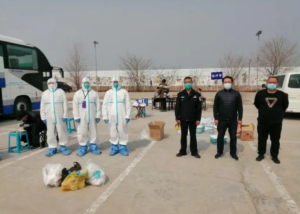
Ten questions and answers about the new crown, reinfection, and the “fourth vaccination”!
Recently, with the recovery of some newly infected patients with pneumonia, “re-positive” and re-infection have become the focus of attention. How to distinguish between “re-surgery” and re-infection? Is “re-surgery” infectious? How contagious is it if re-infected with neointestinal pneumonia? Will the disease worsen?
Li Dongzeng, chief physician of the Department of Infection, Beijing Youan Hospital, Capital Medical University, Wang Xinyu, deputy director of the Department of Infection, Huashan Hospital, Fudan University, and Guo Wei, deputy director of the Department of Infection, Tongji Hospital, Huazhong University of Science and Technology, will answer the questions.
If the test is positive again after the nucleic acid of a newly infected patient has turned negative, is this a “re-positive” or a “re-infection”? How to distinguish?
A “re-positive” usually occurs within a short period of time, say 2 to 3 weeks. The so-called “re-positive” means that the nucleic acid has not completely turned negative, but is still fluctuating at the threshold.
“Reinfection” refers to the phenomenon of the body being invaded by the same virus again after the body has fully recovered from the previous infection, when the level of specific immunity in the body has decreased to a certain level. There is usually an interval of six months or more.
Why do people “come back”?
In some cases, the results of the nucleic acid test are considered to be a reversion to negative after repeated detoxification, which means that the detoxification is intermittent; in other cases, the patient has an underlying lung disease or a high viral load, and the patient turns negative after treatment and then reverts to positive after finishing treatment.
Are both “re-positive” and re-infection with a new crown infectious?
A “re-positive” is generally considered to be the detection of some fragments of the virus in the body, which is not infectious and has no pathogenic power. If it is a reinfection, it is a completely different kind of infection, and it is infectious.
Is there a high probability of “re-infection”?
There is no need to be too concerned about “re-infection” at this time, because this group of people usually does not pose a risk of infection to others around them. From the values we have seen before, it is common to have a “negative” test once and then a “positive” test a second time, but it usually fluctuates for a week or so, after which it is not detected.
What are the circumstances that make reinfection more likely to occur?
After recovering from an infection, the antibody level in the body gradually decreases, and if the prevalent strain of the virus becomes different, the chance of re-infection increases.
People who are immunocompromised are also at risk of reinfection. If there is a more significant mutation of the virus itself, it can also lead to a decrease in the protective capacity of antibodies in the body, raising the risk of secondary infection. Data from current studies show that even when secondary infections occur, the body has less severe symptoms and recovers more quickly.
Can I be re-infected with BF.7 after being infected with BA.5.2 virus?
Usually, after infection with one of the strains, there is still a high level of neutralizing antibodies in the human body for a short period of time. Therefore, the likelihood of being re-infected with BF.7 after being infected with the BA.5.2 strain in the short term is relatively low. However, over a long period of time, there is a possibility of repeated infections with different strains of the virus.
Will the symptoms worsen with reinfection?
In case of reinfection, if the infection is with the same branch of the new crown virus, the symptoms will usually be milder and the duration of the disease will be shorter because the human immune system has a memory. The strains currently prevalent in China are mainly BA.5.2 and BF.7, which belong to the same branch of the virus, and BF.7 is a variant of BA.5.2.
However, if the infection is with a different mutated subtype of virus, it may lead to slightly different pathogenicity. The severity of clinical symptoms is determined by the pathogenicity of the virus on the one hand and the individual differences of the infected person on the other. Even the Delta strain, which used to be relatively pathogenic, can have asymptomatic infections, while Omicron BA.5.2 can have critically ill patients.
Are the currently prevalent strains susceptible to reinfection?
Although many people abroad experience secondary infections during outbreaks of different strains, the hundreds of subbranches of the current Omicron variant are all “close relatives” and are protective against the less obvious variant of the virus when the body has high antibody levels. It is generally believed that people with normal immunity will not be infected for a second time within 3 to 6 months.
What can I do to avoid re-infection after “Yang Kang”?
After recovery, good habits such as wearing a mask, washing hands regularly, opening windows more often, paying attention to social distance, and maintaining cough etiquette should be continued. In addition to protecting against the new coronavirus, masks also provide good protection against other respiratory infections, and the incidence of all types of respiratory infections has decreased in the last three years.
Positive patients should also strengthen their health management after turning negative, have a healthy life and also keep a close watch on their health. In order to avoid recurrence of the disease, families with infected people should use separate daily items such as clothes, bed sheets, towels and utensils, and do as much isolation as possible from each other.
In addition, for those who are not yet infected, it is best to wear high-level protective masks such as N95 or KN95 for the last month or two, and to gather as little as possible, and it is recommended that vaccination be completed as soon as possible, and a second booster vaccination can be completed if possible.
Do I still need to get vaccinated to prevent reinfection after “Yang Kang”? How often should I get vaccinated again?
Since there is still a possibility of reinfection after “yangkang”, theoretically, it is still necessary to get vaccinated again, but there is a limit to the time of vaccination.
According to the staff in charge of vaccination in Beijing Haidian District, people with positive infections who are in the middle of a new coronavirus symptom attack and those who have recovered from the disease should not receive a second booster dose immediately at this stage, and should wait at least 6 months after recovery before consulting a doctor to assess whether their physical state is ready for vaccination.


Average Rating